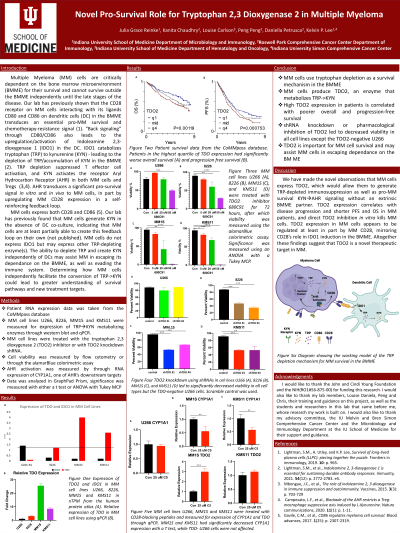Myeloma Novel Drug Targets and agents
Poster Session 2
P-210: Novel Pro-Survival Role for Tryptophan 2,3 Dioxygenase 2 in Multiple Myeloma
Thursday, September 28, 2023
12:30 PM - 1:30 PM EEST


Julia G. Reinke, Bachelor's (she/her/hers)
Graduate Student, Department of Microbiology and Immunology
Indiana University School of Medicine
Indianapolis, Indiana, United States
Introduction: Multiple Myeloma (MM) cells are critically dependent on the bone marrow microenvironment (BMME) for their survival. Our lab has previously shown that the CD28 receptor on MM cells interacting with its ligands CD80 and CD86 on dendritic cells (DC) in the BMME transduces an essential pro-MM survival/chemotherapy-resistance signal. “Backsignaling” through CD80/CD86 also leads to the upregulation/activation of Indoleamine 2,3-dioxygenase 1 (IDO1) in the DC. IDO1 catabolyzes tryptophan (TRP) to kynurenine (KYN) - leading to the depletion of TRP/accumulation of KYN in the BMME. TRP depletion suppressed T cell activation, and KYN activation of its receptor Aryl Hydrocarbon Receptor (AHR) transduces a significant pro-survival signal in vitro and in vivo to MM cells, in part by upregulating MM CD28 expression in a self-reinforcing feedback loop. MM cells express both CD28 and CD86; our lab has previously found that MM cells generate KYN in the absence of DC co-culture, indicating that MM cells are at least partially able to create this feedback loop on their own. This may assist MM in escaping its dependance on the BMME. Determining how MM cells independently facilitate the conversion of TRP>KYN could lead to greater understanding of survival pathways and new treatment targets.
Methods: Patient RNA expression data was taken from the CoMMpass database. MM cell lines U266, 8226, MM1S and KMS11 were measured for expression of TRPKYN metabolizing enzymes through western blot and qPCR. MM cell lines were treated with the tryptophan 2,3 dioxygenase 2 (TDO2) inhibitor or with TDO2 knockdown (KD) shRNA, and also with CD28 blocking peptides. Cell viability was measured by flow cytometry and KYN production by the Ehrlich KYN detection assay.
Results: We found that MM cells don’t express IDO1, but do express the TRP>KYN metabolizing enzyme TDO2. The biological role for TDO2 in MM is completely uncharacterized, but its significance is suggested by our finding that in patients, TDO2 expression increased with disease progression and that patients with the highest quartile of TDO2 expression have significantly shorter progression free and overall survival. Inhibition of TDO2 pharmacologically or by shRNA KD lead to significantly reduced cell viability. Treatment with CD28-blocking peptides lead to reduced production of KYN, indicating a previously unrecognized regulation of TDO2 by CD28.
Conclusions: We have made the novel observations that MM cells express TDO2, which would allow them to generate TRP-depleted immunosuppression as well as pro-MM survival KYN-AhR signaling without an extrinsic BM ME partner. TDO2 expression correlates with disease progression and shorter PFS and OS in MM patients, and direct TDO2 inhibition in vitro kills MM cells. TDO2 expression in MM cells appears to be regulated at least in part by MM CD28, mirroring CD28’s role in IDO1 induction in the BM ME. Altogether these findings suggest that TDO2 is a novel therapeutic target in MM.
Methods: Patient RNA expression data was taken from the CoMMpass database. MM cell lines U266, 8226, MM1S and KMS11 were measured for expression of TRPKYN metabolizing enzymes through western blot and qPCR. MM cell lines were treated with the tryptophan 2,3 dioxygenase 2 (TDO2) inhibitor or with TDO2 knockdown (KD) shRNA, and also with CD28 blocking peptides. Cell viability was measured by flow cytometry and KYN production by the Ehrlich KYN detection assay.
Results: We found that MM cells don’t express IDO1, but do express the TRP>KYN metabolizing enzyme TDO2. The biological role for TDO2 in MM is completely uncharacterized, but its significance is suggested by our finding that in patients, TDO2 expression increased with disease progression and that patients with the highest quartile of TDO2 expression have significantly shorter progression free and overall survival. Inhibition of TDO2 pharmacologically or by shRNA KD lead to significantly reduced cell viability. Treatment with CD28-blocking peptides lead to reduced production of KYN, indicating a previously unrecognized regulation of TDO2 by CD28.
Conclusions: We have made the novel observations that MM cells express TDO2, which would allow them to generate TRP-depleted immunosuppression as well as pro-MM survival KYN-AhR signaling without an extrinsic BM ME partner. TDO2 expression correlates with disease progression and shorter PFS and OS in MM patients, and direct TDO2 inhibition in vitro kills MM cells. TDO2 expression in MM cells appears to be regulated at least in part by MM CD28, mirroring CD28’s role in IDO1 induction in the BM ME. Altogether these findings suggest that TDO2 is a novel therapeutic target in MM.
